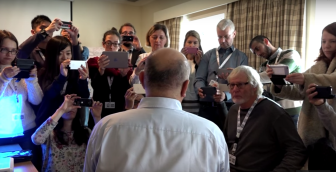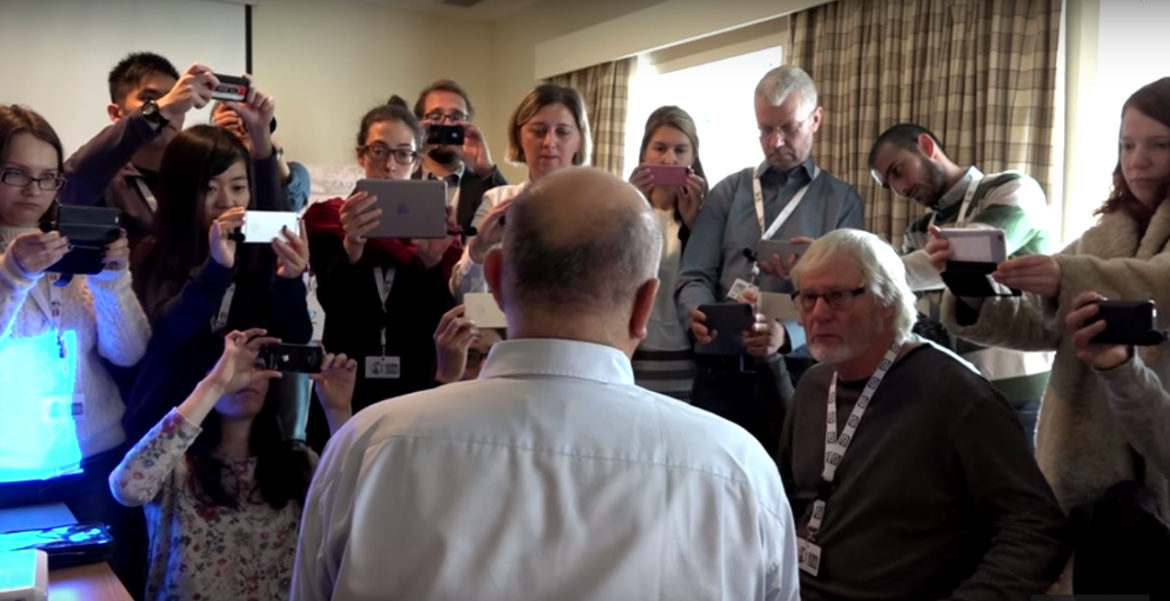 Production gear that used to fill the back of a car now fits in your hand — in a single smartphone. But how do journalists best use mobile phones for reporting? Attendees at the Global Investigative Journalism Conference were treated to a three-hour crash course, the MoJo Master Class.
Production gear that used to fill the back of a car now fits in your hand — in a single smartphone. But how do journalists best use mobile phones for reporting? Attendees at the Global Investigative Journalism Conference were treated to a three-hour crash course, the MoJo Master Class.
Ivo Burum, Australian journalist, author, and award-winning television producer, taught the workshop in which the participants learned basic camera filming, sound recording, and editing on smartphones.
Despite all the cool gadgetry today, Burum stressed that the journalism still comes first. “It’s about storytelling and not about technology,” he told the class.
Burum first outlined the necessary tools and equipment:
- You need a smartphone and preferably an extra microphone. The microphone can either be external or a wireless.
- A tripod makes it easier to film stand ups, pan, and tilt.
- You will need an editing app such as iMovie for iPhone and Kinemaster Pro for Androids. These apps offer two-track editing. He also advised that using apps for filming allows you to have more control of the video recording. Filming Pro was one of the apps he recommended.
Burum then gave the participants assignments and showed them step-by-step how to film.
Filming Tips
Among Burum’s filming tips:
- Remember to have what you want to film in focus. Tap on the screen where you want to focus. There is a function for locking the focus. On iPhones this button is called AF/AF lock.
- Be aware of the lighting. Film from the light’s direction, and avoid filming towards the light. If you want to correct the lighting, there are buttons to raise or lower the exposure.
- Smartphones usually have two cameras. The camera on the same side of the screen has lower quality than the one on the back of the phone. If you are filming yourself, turn the phone around and use a tripod.
- Put your phone in flight mode. Doing this will mean that you will not be interrupted by calls or text messages, and the Wi-Fi will not interfere with the recording.
- Remember to film B-roll. This gives you important fill-in footage that allows you to cover up jump cuts, or highlight something or could even be used to introduce someone. Ten seconds is a good time to hold the B roll shots.
- Film both close-ups and wide shots. If you have a microphone attached to your smartphone, then the audio will have higher quality close-ups.
Voiceover Tips
- Burum recommended filming the voiceover instead of audio recording it. This will provide all the files you will use in the same folder when you start to edit.
- Hold your hand over the camera and record when you speak. The video file will then be all black and easier to find among the video files.
Editing Tips
After everyone was done filming, Burum had a quick lesson on how to edit using iMovie. Here are the basic steps:
- Open the editing app and use the landscape format. Click on create a new project and then press movie.
- Press the question mark if you are unsure what the buttons to edit are doing.
- Go to media
 to chose what videos you want to use.
to chose what videos you want to use. - If you want to turn the sound up or down, press the speaker to reveal the audio bar.
- Add B-roll by adding the video track above the first track.
- If you want to add special effects (like adding texts) then press settings
 and then press news under themes.
and then press news under themes.
If you want to learn more about how to Smartmojo and what equipment you need:
- Visit Ivo Burum’s website on http://smartmojo.com;
- Take a look to his tipsheet from his workshop at IJAsia 16; and
- Check out the tipsheet by Seamus Reynolds from the African Investigative Journalism Conference 2016.
Line Løtveit a journalism student at the University College of Volda who is on special assignment covering #gijc15.

